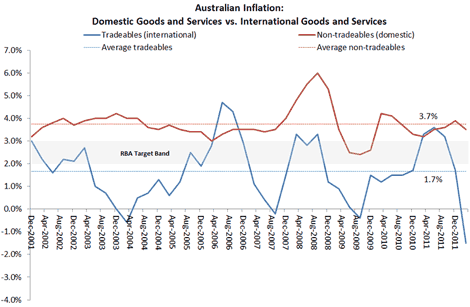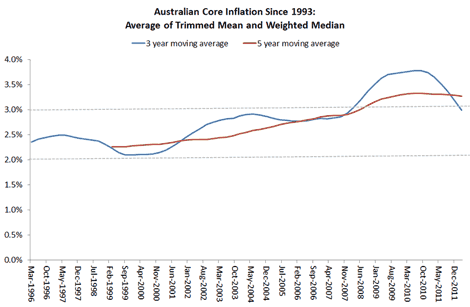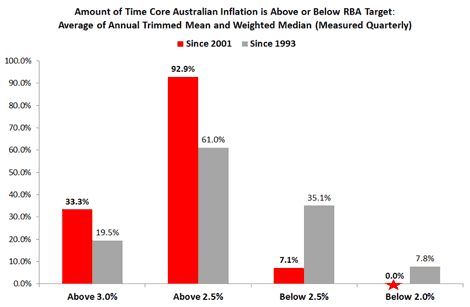A 50-basis-point interest rate cut would undermine the RBA’s credibility: Christopher Joye

Today I am going to dive into two controversial issues: whether the RBA “should” cut rates by 25 or 50 basis points next week, and what I call the “great RBA counter-factual”. That is, what Australia’s inflation rate would have looked like had the RBA not made its many purported policy “errors”.
Let’s deal with the second issue first. You have to pity our inflation-targeting central bank. You get consistently high underlying inflation, and you get slammed. You do the job you were given, lift interest rates, and allow the currency to appreciate (as you expected), and you get some low inflation. Just what you were shooting for.
And, by the way, “low inflation” is not something Australians are used to seeing. It’s not even really that low – still above the bottom of the RBA’s target 2% to 3% per annum band – and when you strip out “internationally traded” good and services, you find that Australia’s “domestic” inflation looks pretty ugly. But you still get slammed again. According to Alan Kohler today, you will be a “bedraggled, hangdog group of economists who shuffle” into your board meeting next week.
Apparently you made a huge mistake delivering what you were supposed to: much lower tradeables inflation, which is the only reason overall Australian inflation has been wrenched back down towards the bottom of your mandated zone.
Yep, because of the RBA’s decisions, Australia’s economic station looks horrific: we’ve had the first mining boom in recorded history without a major inflation outbreak, 5.2% unemployment, interest rates around their long-term averages, business surveys that suggest growth is near trend (as does the unemployment rate), and underlying consumer inflation of 2.2% per annum, which is still above the targets of most other central banks.
There is an enormous amount of circularity in the current debate about Australian inflation and interest rates. Contrary to popular myth, the latest inflation results are not a disaster. They are the very pleasing and expected result of the RBA’s considered policy actions.
Let me put prove this point graphically. If you compare inflation in "domestic" goods and services (called "non-tradeables"), which also happen to be things that we tend to buy more frequently (and are associated with “cost of living” perceptions) with inflation in so-called "tradeables", which are those goods and services that the ABS defines as having their prices determined in global markets, you will see that almost all the reduction in Australian inflation has been driven by these global consumer prices. And the reason these prices have been falling is because of the appreciation in Australia’s trade-weighted exchange rate, which is one of the RBA’s two key policy tools.
This is illustrated strikingly by the blue line in the chart. Overall inflation is a combination of the blue and red lines. What you can see is that inflation in non-tradeables (i.e., domestic items) remains way above the RBA's target, and is in line with its average 3.7% per annum rate since December 2001.
Click to enlargeSo this is where the debate about interest rates and inflation becomes circular. Those arguing for much lower interest rates, and a much lower currency, are, by definition, comfortable with higher tradeables inflation. A big decline in the currency would reverse-out a lot of the deflationary benefits yielded by the blue line slumping in the chart above. And without this tradeables deflation we would likely have an overall inflation problem, given domestic consumer prices have been expanding at 3.5% per annum.
One of the reasons "tradeables" inflation has averaged only 1.7% per annum since 2001 is because our main trading partners, such as China, were flooding our markets with cheap imports – that is, exporting deflation. This dynamic has slowed due to rising wage costs and inflation in China and India. As the RBA has observed (and I’ve argued here for years), China is now a source of inflation rather than disinflation. That means that in the future, tradeables inflation will likely be higher than it was during the 2000s.
A related question is whether core inflation of 2.2% per annum, or lower, is such a bad thing. What has happened to core inflation in Australia since the RBA began targeting it in 1993? Is there any evidence we’ve had a structural inflation problem?
And, on a more nuanced level, what does the distribution of inflation outcomes since 1993 look like? That is, does the RBA struggle to keep core inflation around the mid-point of its already high and wide (by international standards) 2% to 3% per annum target band? Do we have a bias in Australia towards high rather than low core inflation outcomes?
To try and answer these questions I have started with a chart that illustrates Australia’s core inflation rate on a three-year and five-year moving average basis since 1993. This suggests that during the 1990s and 2000s there did indeed seem to be an upward drift in underlying Australian inflation. The RBA has acknowledged as much, conceding that it finds it hard to forecast high core inflation events. (The same phenomenon was also found in consumer inflation expectations, which is arguably more worrying.)
Click to enlargeA possibly more interesting analysis is to measure the amount of time Australia’s core inflation rate is above or below the mid-point of the RBA’s target zone. I’ve done this for two periods: since 1993 and since December 2001 (i.e., after the introduction of the GST) in my final charts.
The results are remarkable. Over the last decade plus, core inflation in Australia has been above the mid-point of the RBA’s target 2% to 3% band an extraordinary 92.9% of the time. It has been above 3% per annum an equally amazing 33.3% of the time. It has been below the mid-point only 7.1% of the time. And since 2001 it has never been less than 2% per annum (year-on-year rolling quarterly). That will hopefully change next quarter.
Click to enlargeIf we examine the RBA’s track record over the full inflation-targeting period of March 1993 to March 2012 we find similar results: core inflation has been less than 2.5% per annum only 35.1% of the time, but above the mid-point 61% of the time (there have been three quarters in which year-on-year inflation was exactly 2.5%).
This strong asymmetry in Australian inflation, whereby it tends to overshoot rather than undershoot the target, is also evident when we look at the top and bottom of the band. Whereas core inflation has been above 3% per annum around 20% of the time over the last 19 years, it has been below 2% per annum only 8% of the time.
Inflation is a tax on your purchasing power and savings. That’s precisely why the central bank’s job is to keep it low and steady. Having a core inflation rate of around 2% per annum when it is being driven almost entirely by tradeables deflation, is a good policy outcome whilst non-tradeables inflation is running at 3.5% per annum.
With that explanation behind us, let’s think about the RBA’s May meeting. The arguments in favour of a 50-basis-point cut are obvious and simple: the RBA’s made a terrible policy error, is now behind the inflation curve, and it needs to slash rates, and pull the currency down, to save trade-affected industries.
Another argument is that the RBA will not want to cut after the budget for fear of being seen to be endorsing the government’s decisions.
The arguments against 50 basis points, and in favour of a one quarter of a percentage point cut, are more nuanced (and accurate). The first is that a 50 basis point move signals the RBA has made a mistake, and undermines its credibility.
A second is that if the RBA wants to genuinely stimulate the economy, it will get more bang for its buck by spreading the cuts out over multiple months and maximising the “jaw-boning” effect.
I’ve talked a lot in the past about the virtual rate hikes we had in 2011 care of the RBA regularly beating the inflation drum, which everyone seemed to accept. The same is true in reverse, but most commentators appear to have forgotten. The media can get the community all excited about interest rate relief in May and June, rather than just in May alone. It’s smart psychology.
A third reason to go 25 rather than 50 is a very poorly understood problem that a big cut creates for the banks. I was speaking to the treasurer of a bank about this issue on Friday. He said to me, “God, I hope the RBA goes 25 and not 50.” I was a little surprised, and asked him why.
He explained that because all the banks have so much retail money tied up in term deposits these days, and because their variable-rate “wholesale funding” prices off the three month bank bill rate, a sudden cut in rates actually damages bank profitability. That’s because the banks cannot immediately reduce all the retail deposit and wholesale funding rates for existing funders.
So, perversely, by cutting 50 you are actually going to encourage the banks to pass on even less to borrowers to save their margins because they cannot immediately reduce their funding costs by the same amount as the RBA’s cash rate change. This bank treasurer argued that all Australian banks will have the same problem.
A final obvious reason to go 25 and not 50 is that you get the benefit of much more information. You get to evaluate the budget, see the next round of unemployment and labour cost data, watch the reaction of the currency, and then re-calibrate your growth and inflation forecasts. And a one month delay is not going to make a material difference to the economy.
Of course, exactly what the RBA does on Tuesday is harder to call. The six business executives on the board will probably opt for the simpler story that says the RBA has to slash rates by 50 to save the economy from low inflation. They would be wrong.
Christopher Joye is a leading financial economist and a director of Yellow Brick Road Funds Management and Rismark. The above article is not investment advice.


